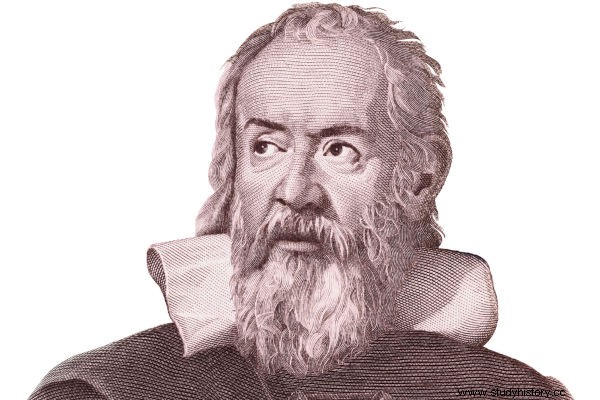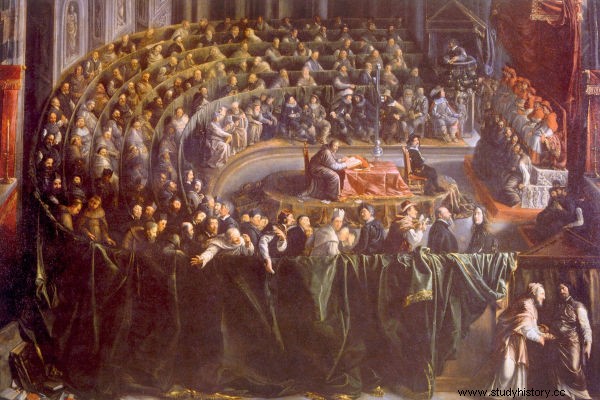
Galileo Galilei he was an important scientist of the Renaissance who made important contributions to different areas of knowledge, such as Mathematics, Astronomy and Physics. He was noted for making astronomical observations and for defending the Copernican model, which states that the Sun is the center of the Universe and that the planets revolve around it.
The physicist came to study Medicine at the insistence of his father, but he abandoned the course and developed a career in another area of knowledge. He made important inventions, such as the thermoscope, and got into trouble with the Holy Inquisition for defending the centrality of the Sun. He spent the last few years of his life under house arrest for espousing the heliocentric theory.
See also: How was the establishment of the Catholic Church in the Middle Ages?
Galileo Galilei Summary
-
Galileo Galilei was born in Pisa on February 15, 1564.
-
He started his studies in Medicine, but abandoned the course.
-
He made important contributions to Physics, Mathematics and Astronomy.
-
He became a strong supporter of the Copernican model, that is, of the idea that the Sun is the center of the Universe.
-
he was tried by the Inquisition twice for advocating heliocentrism and forced to deny the theory.
-
he died under house arrest.
Biography of Galileo Galilei
→ Galileo Galilei's Early Years
Galileo Galilei born February 15, 1564 na city of Pisa, currently located in Italy, but which at the time was part of the Duchy of Florence. His parents were Vincenzo Galilei, who worked as a musician, and Giulia Ammannati. Galileo was the eldest son of this couple who, in all, had six children.
Galileo's family moved to Florence when the young man was eight, but he was taken care of by a tutor named Jacobo Borghini. Your education was carried out in a monastery which was close to Florence, where he had access to the basic knowledge that was taught in the Renaissance period.
The young man's experience in the monastery developed in him the desire to follow the ecclesiastical life, what his father didn't allow , the guiding you to do Medicine . That's because Vincenzo wanted Galileo to become a doctor, as it was a career that would bring greater financial returns.
→ Adult Life of Galileo Galilei
Galileo was enrolled in Medicine at the University of Pisa in 1581, but during the course he realized that he had no taste for this area of knowledge. He ended up attending, by chance, a lecture on Mathematics given by Professor Ostilio Ricci. He realized then that would actually like to study M thematics .
Before that, Galileo had had a significant experience. As he studied, he observed that a chandelier swung from side to side due to the force of the wind. He was intrigued by this movement and decided to do an experiment in his house, identifying that a pendulum took the same time to swing on each of the two sides it moved.
This conclusion by Galileo Galilei was instrumental in formulating what is known as the Law of the Pendulum . He managed to convince his father to let him switch majors. From then on, he was personally accompanied by Ostilio Ricci, who identified that the boy was a promising student.
However, Galileo abandoned the course Mathematics in 1585 . After that, he made his living teaching mathematics to students and working in art schools in Florence. In 1589, he won a place to work at the University of Pisa.
There is a theory that at this time Galileo accomplished an impressive feat, for he demonstrated that a theory that had been sustained since the time of Aristotle was incorrect . In this theory, Aristotle claimed that a heavier object fell with greater speed towards the ground than a lighter object.
Galileo would have proved that, in fact, both objects fall at the same speed. Supposedly, he would have attested to this by throwing metal balls of different weights from the top of the Leaning Tower of Pisa. The balls hit the ground at the same instant, thus proving his theory.
After Galileo's contract with the University of Pisa ended, he went to work at the University of Padua, where he worked in fields of knowledge such as Astronomy. In fact, astronomy, as we will see, is one of the fields in which Galileo stood out the most.
At this stage of his life, the scientist invented a kind of thermometer, called a thermoscope . This object was able to identify the temperature variations of the climate. In addition, he created a compass that was widely used by artillery armies of the period. These inventions provided him with extra income, which was important in the economic management of his family.
Also know: Plato — important philosopher of antiquity
Galileo Galilei's Studies in Astronomy
In 1609, Galileo Galilei decided to build a telescope after news broke that a Dutch eyeglass maker named Hans Lippershey had invented this object. Right from the start, Galileo managed to build telescopes better than the Dutch one. Through them, the physicist started a work that if extended throughout his life:observation of the Universe .
Galileo was already a well-known figure in the Italian peninsula, but his studies in Astronomy ensured him greater prestige as an intellectual. Shortly after the production of his first telescopes, Galileo built a device 30 times more powerful than that of Hans Lippershey and used it to make several observations.
In one of them, the astronomer found that the surface of l ua is full of imperfections . This came as a shock to many people, as many believed that the lunar surface was perfectly smooth, like a pearl.
Galileo Galilei was responsible for discovering four satellites orbiting Jupiter . Initially, he thought they were stars, but upon closer inspection, he realized that they were actually bodies orbiting the planet.
This was a significant discovery for him. Immediately, Galileo questioned the Ptolemaic model , at the time recognized by many as real. In this model, the Earth is the center of the Universe and all celestial bodies orbit around it.
From then on, Galileo supported the Copernican model. This model, developed by Nicolaus Copernicus, declares that the Sun is the center of the Universe, and the planets, including the Earth, revolve around it.
Galileo Galilei still conducted observations on planets like Venus and Saturn , even getting to observe its rings. These new observations only reinforced the scientist's position on the Copernican model.
Galileo Galilei and the Holy Inquisition

Defender the heliocentrism t takes risks for the astronomer and his followers. Many still believed in the Ptolemaic model, using biblical passages to defend it, not least because the Catholic Church itself defended this theory. In this context, Galileo's work began to attract attention.
In late 1613, an influential woman from Florence, known as Christina of Lorraine (or Christine of Florence), questioned a follower of Galileo about the Copernican model and raised objections based on the Bible. The physicist then wrote her two letters, defending the heliocentric model based on scientific arguments.
The letters circulated freely throughout the Italian peninsula. In them, Galileo stated that he respected and believed in the Bible, but that it was not a basis for scientific studies. Shortly thereafter, in 1615 he was denounced to Holy Inquisition for heresy . His writings on heliocentrism had landed him in the dock of the Inquisition.
At the conclusion of the investigation, Galileo was not convicted, but was warned not to defend the Copernican model . In addition, it was determined that the publication of Copernicus' books was prohibited. Thus, the astronomer stopped advocating heliocentrism publicly and continued with his studies.
In 1632, Galileo published a book, with the permission of the Catholic Church, which had enormous repercussions. The work is called Dialogue on the Two Major World Systems . Because of the book, the scientist was accused by Pope Urban VIII of defending the heliocentric theory, as the characters argued over the Copernican and Ptolemaic models. Again, he was accused by the Holy Inquisition .
In the retrial, Galileo was threatened with torture and thanks to publicly deny heliocentrism . He was also sentenced to spend the rest of his life under house arrest, which he served at his home on the outskirts of Florence. His book was also banned by the Inquisition.
Also read: Martin Luther — the questioner of the Catholic Church who started the Protestant Reformation
Death of Galileo Galilei
Galileo's last years were spent in his home, due to the conviction, and he left only on occasions authorized by the Inquisition. He developed health problems and became blind. The astronomer died January 8, 1642 . The Catholic Church only admitted that it was wrong about the Galileo trial in 1992.
